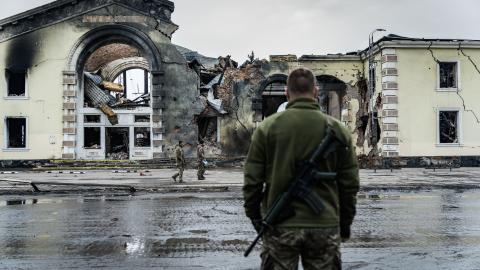After months of contentious debate, the House of Representatives is nearing a vote on aid to Ukraine, Israel and Taiwan. The military assistance to Ukraine is the most urgent matter, and it is the point of greatest disagreement.
Two questions will be decisive: Why should the United States continue to support Ukraine? Is there a plan to defeat Russian President Vladimir Putin’s invasion?
This month, experts from Washington’s Hudson Institute traveled to Kyiv and Odesa. We found that American support for Ukraine is more important than ever. Ukraine’s resolve, innovation and battlefield successes make clear that supporting their plan for the months ahead is in the best interests of the United States.
How Ukrainians have fought Russian forces
Ukraine’s leaders have a plan for victory. It begins with isolating and weakening Russia. Ukrainian forces have done much more than merely fend off conquest − they have taken back half the territory seized during the initial invasion, have destroyed approximately one-third of Russia’s Black Sea fleet despite possessing no navy, and have waged a systematic campaign of attrition against the Russian Aerospace Forces.
If past is prologue, Russian forces are in for a bloody year.
Without a single U.S. or NATO soldier firing a shot, Russia has suffered losses of manpower and equipment it has not seen since World War II. By one estimate we heard in Kyiv, Russian casualties may have eclipsed 500,000 men. Many Russian units have been shattered, including special elite troops, and in two years, Ukraine has killed more high-ranking Russian general officers than were killed over the decadelong wars in Afghanistan and Syria.
Ukraine also plans to counter Russia’s reliance on attritional warfare. Ukraine is pioneering disruptive battlefield technologies and fielding them at scale. This year, Kyiv will produce a million killer drones.
Ukraine burns. Republicans and Biden dither. And Russia's Vladimir Putin smiles.
Ukraine also now possesses the ability to attack vital Russian positions on NATO’s doorstep, like occupied Crimea, and threaten Russian troops elsewhere, as in Transnistria (the Russian-backed enclave in Moldova).
Ukraine’s offensive capability opens a path to end the war on terms favorable to Ukraine.
What Ukraine needs: US and NATO weapons systems
Yet, this success depends on protecting Ukraine’s population and infrastructure from long-range Russian strikes − protection that available U.S. and NATO weapons systems can easily provide at minimal cost to the West.
Restocking Kyiv’s arsenal of Patriot missiles and other air defense systems, augmenting its long-range strike options, and topping up its supply of traditional artillery rounds and mortars will help repel Russian attacks.
The United Kingdom’s “Storm Shadow” air-launched cruise missile and its French SCALP counterpart are especially effective against high-value targets, and the German Taurus system would enhance the power of the F-16 fighter aircraft that Ukraine will operate later this year. Crucially, the U.S. Army Tactical Missile System (ATACMS) possesses the range to threaten Russian forces.
Critics of providing Ukraine with these advanced weapons argue that doing so leaves Taiwan vulnerable to Beijing’s predations. They are clearly correct that China is intent on subjugating Taiwan.
In his latest annual report to the National People’s Congress, Chinese Premier Li Qiang intentionally omitted the word “peaceful” when advocating for reunification of the two polities. Yet, critics of aiding Ukraine fail to note that the enemies of America and its allies have united.
China, Russia, Iran and North Korea have created an alliance. They share munitions, supplies, technology and financial tools, while coordinating military and diplomatic strategies worldwide. With support from Beijing, Tehran and Pyongyang, Moscow is not just attacking Ukraine – it's threatening the entire free world.
Blame Hamas for attacking Israel, but wars do not happen in isolation. Look at Ukraine.
This is why, despite volumes of misinformation suggesting otherwise, our European allies have given more per capita to Ukraine than the United States has contributed. These allies provide Washington with the economic and military power necessary to match China and Russia.
The Beijing-Moscow-Iran-North Korea axis wants to weaken Europe to divide democracies and take them on as disunited and weak. Despite the many frustrations inherent in a partnership of free peoples, the transatlantic alliance makes the United States stronger, and our adversaries know it.
Ukraine is the strategic hinge of Europe, where the battle for the future of Europe and the Indo-Pacific is unfolding. Declining to fight that battle out of fear of provoking a Russian response runs counter to U.S. security and the alliances that give America the power to protect itself with its allies.
Supplying Ukraine with weapons like the ATACMS doesn’t just help Ukraine. It also puts the United States in a position to deter our adversaries.
China, Russia, Iran and North Korea want nothing more than to build a world order that they will control. Providing Ukraine with the means to pursue victory is a crucial step in ensuring that they fail.















